by Briscoe White | Feb 2, 2011 | Exploring, Miscellaneous, Wildlife |

Photo Courtesy of Brad Fenson
Working in the greenhouse today, we were lured from our mundane task by the uproar of several hundred, maybe a thousand Canadian Geese in the adjacent field. After a few moments of loud and excited goose talk, we all ran outside to see them fly over. Whatever it was that scared them was not so bad because most settled back where they began. Some landed in the field beyond our orchard, giving us a clear view of flock after flock gliding in on set wings.
We went back to work when most of the birds had settled back in the fields, foraging ravenously before the next cold weather arrives. And we went back to inventory. But even counting everything is not so bad when you can take a break with the neighbors every now and then.
by Herb Exchange | Jan 27, 2011 | Herbs, Miscellaneous, Recipes |
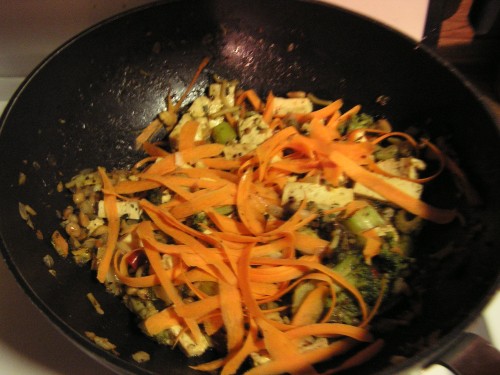
This is an easy recipe for even the worst cook out there! You can add whatever you like, flavor to your desired intensity and best of all, it’s super healthy and cheap to make! Try substituting your protein source if you’re not into tofu…chicken or shrimp will also work well!
Ingredients
- Canola Oil (enough to coat the bottom of the wok)
- 1 Pkg Organic Firm Tofu
- 1 Bag Frozen Vegetables ( I used a stir fry mix that included broccoli, mushrooms, red peppers and rice noodles)
- 3 Spears Fresh Celery
- 1 Carrot, Shaved
- 1/4 Chopped Onion (or add to taste)
- 1 Cup Crushed Peanuts
- Crushed Red Pepper Flakes (to taste)
Marinade
- 1 Cup General Tso Sauce ( I found this prepackaged at the grocery store)
- 1/2 Cup Thai Basil ‘Siam Queen’ (dried from fresh plants)
- 2 Cloves Fresh Garlic
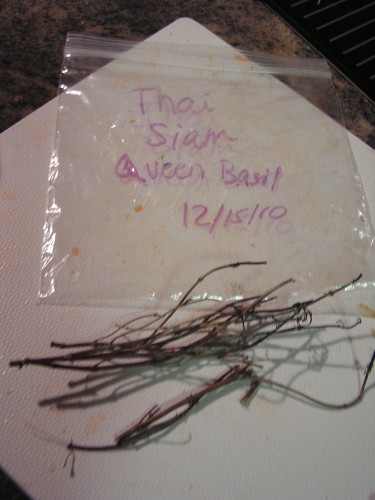
The ‘Siam Queen’ Thai Basil I used was grown right here on our farm at The Growers Exchange! I salvaged one of the plants before it was done for the season and brought it home to experiment with. When I realized that my cats were going to eat it if I didn’t do something with it quickly, I snipped the stems at the soil level and dried the leafy stalks in my warm, dry pantry. (Our of their furry, destructive reach!) After it was dried, I placed it, stems and all, into a labeled zip lock baggie for later used. Removing the dried leaves were easy–just rub the sides of the bag together and they literally crumble from the stems into a perfect dried seasoning. Remove the stems and you have a delicious culinary herb with sweet, licorice and lemon flavored tones.
Don’t be intimidated to use new herbs, as I was at first with this exotic Basil. Being so used to its Italian cousins, like the ‘Italian Large Leaf’ Basil, I was a bit pessimistic when planning my meal, since it was a new flavor. (‘Lemon Sweet Dani’ Basil, another lemon-anise flavored Basil, may also be a great flavor to add to your favorite Asian recipe) Luckily, it turned out GREAT! Try using new culinary herbs in your recipes and you might surprise yourself as to the exciting new flavors you discover!
Instructions
**This works best if your vegetables are either fresh or you have thawed your frozen veggies prior to cooking.
Heat your wok on medium heat and add canola oil til it coats the bottom. While this is heating, slice tofu into even pieces and press excess water out. Add pressed tofu, General Tso sauce, 2 cloves of fresh garlic, and 1/2 of the Basil ‘Siam Queen’ to a bowl and let marinate. Make sure all pieces are coated. (You can also let your protein marinade over night which will make it more flavorful. Because tofu absorbs sauce or seasoning easily, it may not need as long to marinate. For chicken, shrimp or other proteins, they may take long to absorb the desired amount of flavor).
Add a clove of garlic and the chopped onion to the heated canola oil in the wok and let them simmer for a minute to release their flavor. Then, add vegetable mix, chopped celery, crushed peanuts and season with the remaining ‘Siam Queen’ Basil and red pepper flakes. Let this simmer together, remaining on medium to low heat, and stir occasionally. Once mixture seems to be cooked thoroughly and there are no frozen pieces left, add marinated tofu. Stir and let cook for 3-5 minutes or until tofu has cooked through and mixture seems well combined and cooked. (The air in your kitchen should be brimming with aromas by now!) Top with shaved carrot and let simmer for another minute, but remove from heat before carrot is wilted.
Serve and top with more crushed peanut. You can also use an edible, aromatic herb like ‘Citrus Kitchen’ Mint as a great garnish. Eat and enjoy!
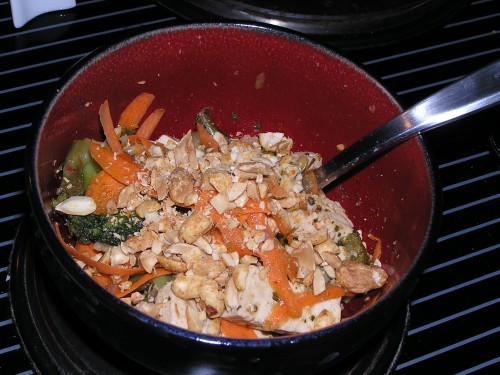
by Briscoe White | Jan 21, 2011 | Life on the Farm, Miscellaneous, Wildlife |
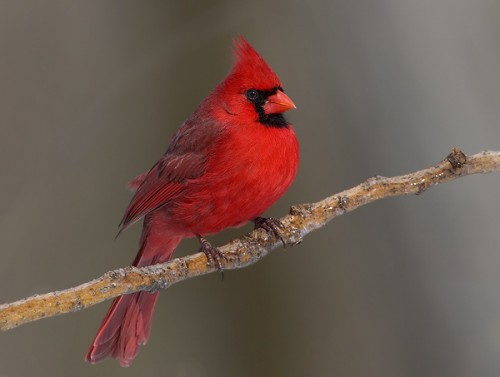
Though beautiful, cardinals can be extremely vain!
Recently, at the end the day, I noticed a departing greenhouse worker remove a plastic nursery pot from each rear view mirror and stow them in his tool box. Old memories awakened as I asked him what was up with his mirrors. “That damn bird!” was his answer, and I knew a red bird had found his truck.
For as long as our greenhouses have been here, people working there have parked outside. And just as long, cardinals have found themselves irresistible in our rear view mirrors. Or maybe they see a rival that s equally matched? Whatever they see, it causes them to stay a long time and return frequently. And while they are looking deeply into the mirror, they are also digesting and leaving their droppings in large quantities. The mess is even worse when car windows are left down, then the inside is fouled too.

To keep our vehicles clean, we have to hide our mirrors from narcissistic birds!
Over the years, employees have tried various methods for stopping the cardinals from soiling their cars. Socks, hats, and various other items have been selected. But the best I have seen yet is an old nursery pot. We do try and cooperate with nature, but do not feel we need to share our vehicles with the birds.
by Briscoe White | Jan 18, 2011 | Containers, Gardening, Growing, Herbs, Indoor Gardening, Miscellaneous, Recipes |
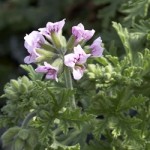
Citronella Scented Geranium
Long-loved for their intense fragrances that range from fruity and floral, to earthy and spicy, Scented Geraniums, or Pelargoniums are an amazingly aromatic ornamental and culinary herb. Cousin to the garden-variety red “grandma’s Geranium” seen so often growing in window boxes and flower beds across the South, Pelargoniums are in the same family and though they share the name, are not “true” Geraniums. First discovered in the 1600’s in South Africa, Pelargoniums were originally lumped in with Geraniums because of their resemblance and similar habit, but as their popularity rose and botany progressed, their taxonomy changed and they were given their own distinction. They received the name, Pelargonium to define them separately, which is derived from the Greek word for “stork”, as part of the bloom seems similar to a stork’s bill.
Reaching the height of their vogue in the Victorian Era, Scented Geraniums were cultivated in greenhouses throughout Europe for the herb’s numerous rich aromas, until fuel had to be reallocated to war efforts, which left enthusiasts unable to heat their greenhouses. With over two hundred varieties of this lovely, fragrant herb, it’s no surprise that they remain a favorite garden, patio and culinary herb for today’s gardeners. The biggest bonus of the Pelargonium is its intensely scented foliage. Depending on the variety, the leaves may be dainty and lacy, rounded or sharply defined, and come in many different verdant hues from light to dark green, including some species with cream or golden variegation on its fringes. Typically, the plant’s blooms have little to no smell, leaving the leaves with the bulk of the herb’s fragrance. Just as with their leaves, depending on the type of Pelargonium, blossoms may come in a variety of colors, patterns and shapes. Generally they all share the same five-petaled design, offering gardeners the option between pink, purple, white, red and yellow hues, masked centers, and wide or thin blooms. (Some even resembling miniature Orchids!)
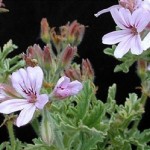
Rose Scented Geranium
In the kitchen, these herbs infuse desserts and other dishes with their scent, and delicately translate their perfumes to our taste buds. Pairing well with fruits like apples, melons and bananas, scents like Rose or Lemon really enhance the flavor of the meal. Try adding some of the Lemon or Peppermint leaves, wholly, to your next iced tea. You can also line the bottom of your cake pans when baking, with Scented Geranium leaves to infuse your favorite cake with a natural flavor. Also used to make syrups, jellies, liqueurs, and flavored butters, Scented Geraniums are a deliciously versatile herb.
Pelargoniums have also long been believed to possess magical and spiritual powers, usually dependent upon the scent or color. Thought to be a good luck charm for healthy, love, protection and powerful in repelling evil and negativity, Scented Geraniums were (and continue to be) used in bath infusions, perfumes, herb pillows and protective sachets. Though used solely in these functions for their fragrance in modern days, superstitions tied to specific scents still linger. It was once believed that Nutmeg Scented Geraniums would bring someone financial good fortune, while Rose Scented varieties would bring a healthy love life. Beliefs were also based on the color of the blooms, such as White Pelargoniums were a symbol of fertility, while Red strains meant strength and protection.
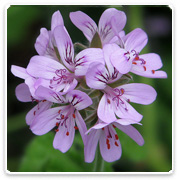
Atomic Snowflake Scented Geranium
Also used in arts and crafts like wreath and potpourri-making because of their long lasting fragrant leaves, Scented Geraniums are like nature’s little air fresheners! Fill your home with citrus and floral scents the natural way and stop using costly, chemical-based candles (plants won’t accidentally burn your house down!) and plug-ins. Lemon and Rose scents tend to grow ideally in containers and make great houseplants. Place them in a sunny window or in a high traffic area–brushing past the scented leaves will release each plant’s specific aroma and will revitalize your senses, especially after a long day. You can also place the leaves in your pillow case or dresser drawer. This will not only repel moths but perfume your laundry and soothe you as you sleep.
Three of our favorite varieties of Scented Geranium are the Citronella, Rose and new this year, the Atomic Snowflake! Each offers a distinct scent and beauty that performs well in the kitchen or garden and is ideal for container growing in or outdoors on patios and windowsills. We love making scented sugar for baking by alternating granulated sugar and Rose Pelargonium leaves, sealing the layers in a jar and leaving it in a sunny window for two weeks. This infuses the sugar with the delicate aroma of fresh cut roses and tastes delicious on cakes and cookies! If grown in high quantity, the Citronella variety is said to repel mosquitoes. Debated in the scientific and gardening communities as to its results, we love its citrusy smell—it reminds us of warm summer evenings. Last and certainly not least, our newest and one of the most beautiful breeds, is the Atomic Snowflake. The name alone brings excitement to mind and its hybrid scent of floral and fruity tones will make a great culinary garnish and a potent perfume for your home or garden!
by Briscoe White | Dec 29, 2010 | Gardening, Inspiration, Life on the Farm |

Well, though it’s too cold to ship most plants for us here at The Growers Exchange, we’re still hard at work sowing and growing for the spring season. Neither wind nor rain nor sleet nor snow have kept us away (someone has to be here to stoke the wood stove that heats the greenhouse!), but it sure makes it worth while to see such wintry natural beauty! When we braved the roads to get to the office after a recent heavy snowstorm, we were greeted with a row of glistening icicles hanging like a frozen curtain from our porch roof.
The recent frigid temperatures have made it hard on any plants left out to fend for themselves, so how can you protect them when the forecast is calling for snow? Cold frames, hoop tunnels and extra mulching are great ways to protect your plants during the cold months. We use cold frames and tunnels to keep the frost from killing herbs like Rue, which we grow in one of our fields for medicinal, culinary and cultural usage. Many supplies needed to build these season-extending protectors, like old lumber or discarded window frames with the panes still intact, can be found laying around your garage or barn. Otherwise the necessary resources can be bought fairly inexpensively at your local hardware store.
Other easy cold thwarting tricks are to plant large, shrubby evergreens or a tough perennial like Rosemary ‘Hardy Hill’, around your garden to protect smaller, more vulnerable plants from icy winds. Positioning your gardens along a south facing wall of your home will also ensure that it gets lots of warmth from the sun as well as heat escaping from your home. For more information on building cold frames or hoop tunnels, check out some of the educational videos listed on YouTube.com, like this one that we found from gardenfork.tv:
How to Build a Cold Frame
by Briscoe White | Dec 17, 2010 | Life on the Farm, Wildlife |
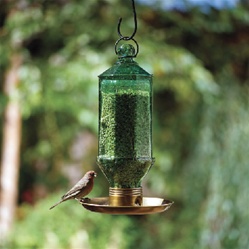
A Bird Buffet!
If your area is experiencing the extreme cold we here in Virginia have, you have probably not thought much about working in the garden. My yard is frozen solid so there is not much that could be done, even if one could stand the frigid temperatures.
Though working soil and plants is a long way off, there is one garden chore we can still do. Feed the birds. Birds don’t just make for an amusing source of natural entertainment, they’re also vital to your garden. Birds help keep your garden pest free while also spreading necessary pollen from plant to plant to aide in plant fertilization. Without these valuable winged friends, we’d be lost, so if you take care of them, they’ll take care of you (and your garden)!
Like many gardeners, I keep several bird feeders in the yard. During cold snaps like this one, the birds need all the help they can get, and respond quickly to any food offered to them. They empty my feeders quickly and sometimes eat it all before they can be refilled. When I go out to refill them, I hear birds chirping and singing as if they know what I am doing. And they do know because the feeders are occupied by the time I am back indoors. Other birds hear the commotion and pretty soon the trees around the feeders are full of birds trying to get to the feeders.
You can also spread seed or place fruit like apples and pears along your porch rails or strung together with a needle and thread and tied to a tree branch, for an added variety of food to attract different types of birds this winter! Try recording how many new varieties you come across and keep a bird journal of their favorite foods, habits, and personalities.
Try adding nesting boxes or bird houses around your yard to encourage your feathered friends to stay longer! Purple Martins, Gold Finches and Bluebirds, to name a few, are very appreciative of a safe, dry place to nest. You can even grow your own! Try growing gourds this year and let them dry. Cut a hole for an opening and hang it for a natural bird abode. Keep your houses and nesting boxes out of the reach of children and pets and do not disturb them for happier house guests.
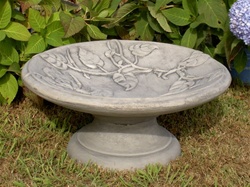
Birdbaths are good for more than bathing!
Even if it’s freezing out, birds also still need a clean water source. Try using one of our birdbaths this winter. You may have to break a little ice each morning to add fresh water, but we promise the birds will thank you. Place your feeders and birdbaths near your porch or window and enjoy the natural entertainment all year long!
Birds are an important part of my yard and garden, they bring action, color, and life. So do not forget them in these tough times and take time to feed the birds!
For more tips on feeding birds through the winter, check our article on caring for birds during the winter.












